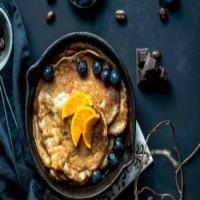Overview
There is a soft place in most hearts reserved for doughnuts: the pillowy texture, the crisp jacket of glazing, the sweetness so sweet it almost could put you off doughnuts, but never does, or at least not for long. In bakeries the warm yellow glow of tray upon tray of doughnuts has greeted many a morning customer and lightened many a load. I remember fondly the maple-frosting-capped pastries that graced the shop in my hometown, and chances are, you have an evocative doughnut memory of your own, a madeleine that's been deep-fat fried.
Fried dough is an old, old vice. It probably has been on the menu for as long as flour has been milled and large quantities of animal fat or oil have been on hand. But doughnuts as we usually imagine them are a relatively young food. The North American version known by that name in shops around the world seems to have its origins in the decades after the American Revolution, when a Dutch treat took on a new identity.
Reading histories of the doughnut, you might be surprised to find that the confection has long been tinged with nationalism. At the same time that the new nation of the United States was trying to find its footing in the world, its denizens were trying to figure out what was essential about it – about its literature, about its national character, about its food. This meant that writers and commentators looked back on the (rather short) history of the country with a kind of nostalgia mingled with bravado.
Before New York was New York, of course, it was New Amsterdam, and writers often reflected on the Dutch customs of earlier eras with treacly fondness. One of these customs was the making of fried dough balls, known as oliekoecken, or oil cakes. A recipe for these treats appears in a 17th-Century Dutch cookbook: they are leavened with yeast and studded with dried fruit.
You might also like:
- The clever science behind frozen ramen
- The man growing lettuce for space stations
- How China learned to love milk
One of the earliest mentions of doughnuts in American writing came from Washington Irving, the writer and diplomat, best known for The Legend of Sleepy Hollow and Rip Van Winkle. In his 1809 Knickerbocker's History of New York, he goes on at length about quaint Amero-Dutch folkways, describing the "primitive tea parties" of the not-so-distant past: "These fashionable parties were generally confined to the higher classes, or noblesse: that is to say, such as kept their own cows and drove their own wagons," he wrote with a mix of sentimentality and condescension. "It was always sure to boast an enormous dish of balls of sweetened dough, fried in hog's fat, and called doughnuts, or olykoeks – a delicious kind of cake, at present scarce known in this city, except in genuine Dutch families."




 Brand Deal
Brand Deal
 Airlines
Airlines
 T-Shirt
T-Shirt
 Style
Style
 Life Style
Life Style





Review (0)
Deixe um Comentário
Conecte-se
Não tem conta Sign up